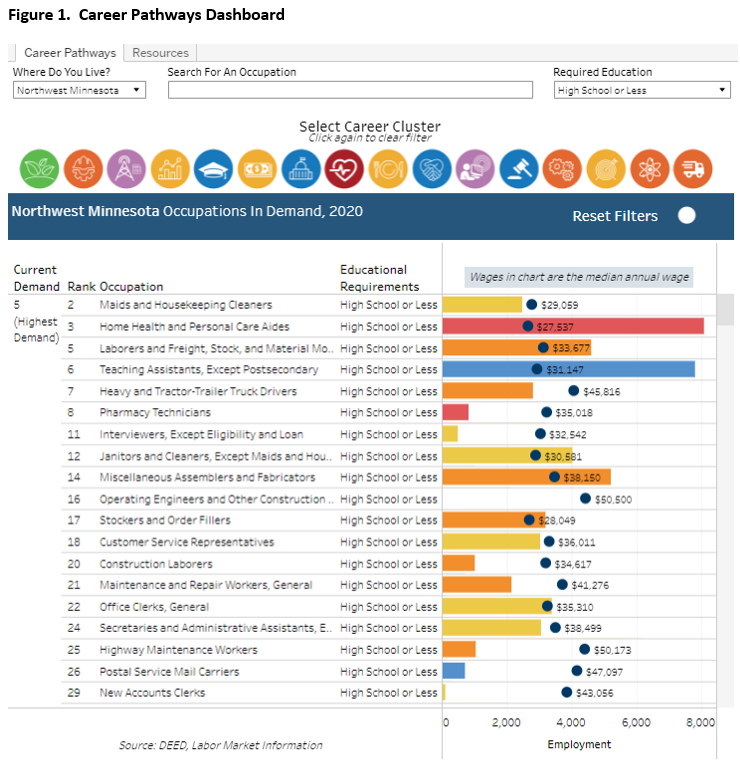 The presence of such industry powerhouses as Polaris, Arctic Cat and New Flyer make Northwest Minnesota a hub of transportation equipment manufacturing.
The presence of such industry powerhouses as Polaris, Arctic Cat and New Flyer make Northwest Minnesota a hub of transportation equipment manufacturing.
From wheat and potatoes to soybeans and sugar beets, the region is a major producer and processor of food staples and specialty agricultural products.
Want the freshest data delivered by email? Subscribe to our regional newsletters.
2/24/2021 9:00:00 AM
Erik White
This pandemic has affected many aspects of the economy and these impacts may be lasting. To help people who are considering changing careers or are transitioning into the labor force, especially high school students, DEED has an updated Career Pathways tool that aligns educational programming with employment opportunities in the region that can be utilized for those that might be exploring career options or seeking a new career.
The latest Local Area Unemployment Statistics for December 2020 shows an unemployment rate of 5.0% for Northwest Minnesota, a rate that is lower than it was a year ago, prior to the COVID-19 pandemic. While that sounds like good news, the lower unemployment rate is concealing the fact that more than 5,400 people in the region have left the labor force over the past year. In the midst of the pandemic, they are not working and are not currently seeking employment. There are a myriad of reasons for this phenomenon including: health concerns, child care responsibilities and early retirement.
| Unemp. Rate | Labor Force | Employed Workers | Unemployed Workers | |
|---|---|---|---|---|
| DEC 2020 | 5.0% | 302,897 | 286,608 | 15,289 |
| DEC 2019 | 5.3% | 308,268 | 292,042 | 16,226 |
| OTY Change | -0.3% | -5,371 | -5,434 | -937 |
| Source: DEED's Local Area Unemployment Statistics (LAUS) | ||||
Whatever the reason, there will need to be efforts to bring back people to the labor force and those seeking a change in careers or entering the job market for the first time will be looking for local opportunities. Fortunately, DEED's Career Pathways data tool provides regional information regarding Occupations in Demand, employment projections, typical wages, required education, and additional resources. Not only does it provide all of this occupational data, but it also puts it in the framework of educational programming from the Minnesota State Career Wheel, which high school students would be very familiar with. This feature should allow those who are looking to transition to a new career to find the pathway that leads to attaining the knowledge, skills and abilities needed for the various professions, whether it's more schooling, a certificate or on-the-job training.
People can use the filters on the tool to match their situation. For example, the Career Pathways data tool shows over 80 occupations that have a 5 or 4 star ranking in Northwest Minnesota that are available with a High School Diploma or less as an education requirement. While many of these jobs have wages below $50,000 a year, there are also many more occupations that make higher wages including: Construction Equipment Operators and Operating Engineers, Highway Maintenance Workers, Stationary Engineers and Boiler Operators, Claims Adjusters, Examiners, and Investigators, First-Line Supervisors of Production Workers, Excavating and Loading Machine Operators, Sales Representatives, Wholesale and Manufacturing, First-Line Supervisors of Correctional Officers, Control and Valve Installers and Repairers, Hearing Aid Specialists, Petroleum Pump System Operators, First-Line Supervisors of Construction Trades and First-Line Supervisors of Office and Administrative Support Workers.

This is just one of many searches that can be conducted on the data tool. For example, if a person is interested in getting an associate degree, they can filter that option with the data tool to find local jobs with that requirement along with information regarding wages, availability, and associated Career Cluster. Aligning the pursuit of education with labor market realities is beneficial to job seekers and the regional economy as a whole.
As the pandemic comes under control in the coming months and we move into economic recovery , utilizing local labor market information will be critical in helping people rejoin the labor force and reskill for in-demand jobs. The Career Pathways tool is a great place to start.
Contact Erik White.